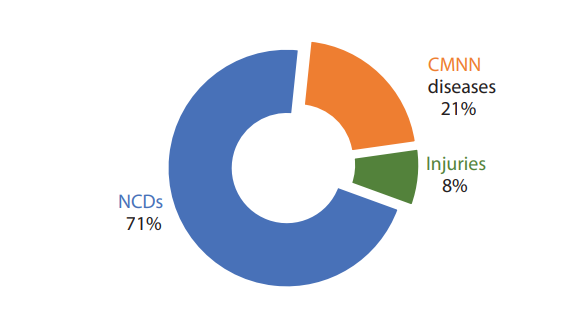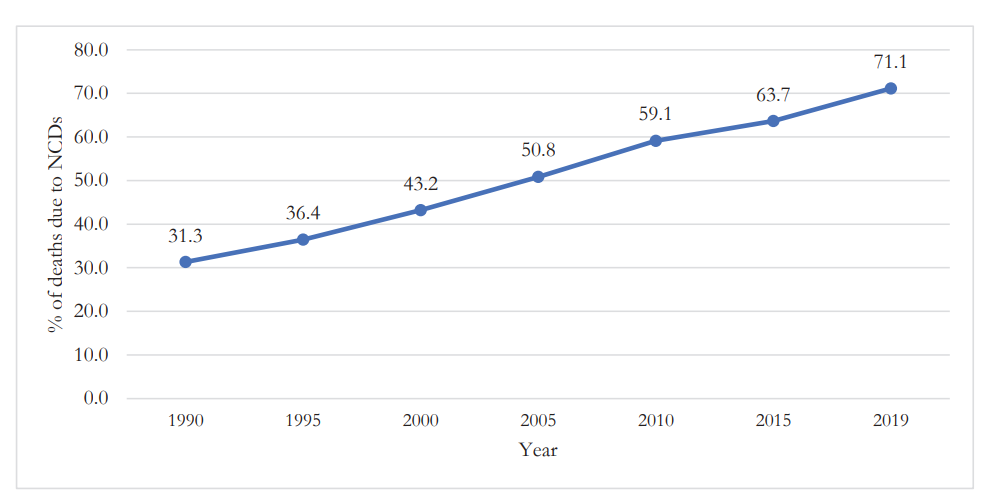Life & Health

Have you ever thought about the top causes of death across the world?
Most deaths in the world are linked with diseases of the heart, lungs and birth conditions, according to a WHO report.
The WHO report tallies the total number of lives lost to three disease groups in technical terms:
cardiovascular grouping ischaemic heart disease and stroke, respiratory including chronic obstructive pulmonary disease and lower respiratory infections and, neonatal conditions meaning birth asphyxia and birth trauma, neonatal sepsis and infections, and preterm birth complications.
Seven of the 10 leading causes of deaths in 2019 were attributed to non-communicable diseases.
So, what were the major causes of deaths in Nepal then?
Non-communicable diseases top the tally of causes leading to deaths of patients in Nepal too.
According to Nepal Burden of Disease 2019, a report of a study conducted jointly by the Nepal Health Research Council (NHRC) and the Ministry of Health and Population, non-communicable diseases caused the most deaths in Nepal.
Of the 193,331 deaths estimated in 2019, 71.1 per cent were attributed to non-communicable diseases, 21.1 per cent to communicable, maternal, neonatal and nutritional diseases and the remaining 7.8 per cent were due to injuries, the NHRC report revealed.
Cardiovascular Disease
Cardiovascular diseases ranked on top as the cause of death of people in Nepal with their 24 per cent contribution to the total number of deaths. Deaths attributable to cardiovascular diseases were 26.8 per cent in males and 20.7 per cent in females, the report said.
Cardiovascular diseases are a group of disorders of the heart and blood vessels. Among the cardiovascular diseases, coronary heart diseases – that is, when the heart's supply is blocked by a build- up of fatty substances, and rheumatic heart diseases are the most common among Nepalis.
Unhealthy diet, physical inactivity, tobacco use and harmful use of alcohol increased the risk of
cardiovascular diseases.
“Cessation of tobacco use, reduction of salt in the diet, consumption of more fruits and vegetables, regular physical exercise, regular health check-up and avoiding alcohol will reduce the risk of cardiovascular disease,” said Dr Anil Bhattarai, associate professor, cardiovascular surgery, Manmohan Cardiothoracic Vascular and Transplant Center.
Chronic Respiratory Disease
Chronic respiratory diseases rank the second among the top causes of deaths in Nepal with 21.1 per cent of total deaths being attributable to them. The proportion of deaths attributable to chronic respiratory diseases was 18.9 per cent in males and 23.8 per cent in females, the report revealed.
Chronic respiratory diseases affect the airways and other structures of the lungs. Some of the most common are chronic obstructive pulmonary disease (COPD), asthma, occupational lung diseases and pulmonary hypertension.
Many Nepalis suffer from chronic obstructive pulmonary disease. In 2019, chronic obstructive pulmonary disease (COPD) was responsible for 16.3 per cent of total deaths which is an increase from 6.1 per cent of total deaths in 1990, the NHRC report said.
The reasons for COPD are smoking -- both first hand and second hand, indoor air pollution – because of an exposure to biomass fuel and environmental pollution. “Construction of chimneys in kitchens, avoiding smoking and an early testing will help people from severity of the disease,” said Dr Kamal Raj Thapa, senior consultant at Chest Department, Bir Hospital.
Neoplasms
According to National Cancer Institute’s dictionary neoplasm is an abnormal mass of tissue that forms when cells grow and divide more than they should or do not die when they should. Neoplasms may be benign (non-cancerous) or malignant (cancerous).
Deaths from neoplasms rank third in position among the causes of deaths in Nepal. As per the NHRC report, malignant neoplasm (cancer) was responsible for 11.2 per cent of total deaths in both sexes, 10.8 per cent of total deaths in males and 11.6 of total deaths in females.
Increasing life expectancy of Nepalis, intake of foods rich in fat, lack of exercise, smoking, alcohol
consumption, infection and an exposure to radiation are some of the causes of neoplasms in Nepalis, according to Dr Prakash Raj Neupane, senior consultant, chief of Cancer Department B&B Hospital.

Respiratory Infections and TB
Respiratory infections and tuberculosis are another major cause of deaths of Nepalis.
Tuberculosis (TB) is an infectious disease caused by a type of bacteria called Mycobacterium
tuberculosis. TB most commonly affects the lungs, when it is called pulmonary tuberculosis, but also can involve any other organ of the body in which case it is called extra-pulmonary tuberculosis.
TB was responsible for 3.9 per cent of total deaths in both sexes, 4.8 per cent of total deaths in males and 2.8 per cent of total deaths in females.
TB can be cured if a full course of the prescribed drugs is taken regularly, and without interruption.
Expansion of the diagnostic centres, trained human resources, and diagnostic tools can help in early identification and reporting of the tuberculosis cases, said Dr Anup Bastola, senior consultant, tropical and infectious disease. “Early diagnosis and treatment can prevent a number of deaths in this category.”
Digestive Diseases
Digestive diseases form another leading cause of deaths of Nepali people, ranked on the fifth position among the top killer diseases. As per the NHRC report, digestive diseases are responsible for 5.9 per cent of total deaths in both sexes, 6.4 per cent of total deaths in males and 5.2 per cent of total deaths in females.
Diarrhoea is one of the common digestive diseases in Nepal, the most common of illnesses among children. It continues to be a major cause of childhood morbidity and mortality in Nepal.
The Nepal Demographic and Health Survey 2016 findings show that the prevalence of diarrhoea among children under age 5 is eight per cent. Children who reside in the Tarai zone are more likely to suffer from diarrhoea (9 per cent) than those in the hills (6 per cent) and mountains (5 per cent).
“Intake of safe food and water and sanitation helps in decreasing the number of deaths from diarrhoea in Nepal,” said Dr Bastola.
(Do visit nepalminute.com or follow our Twitter or Facebook pages to read the Part II - which will be published on Sunday)

_11zon1681280198.jpg)




